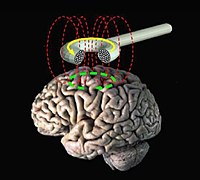
Photo from wikipedia
The ability to plan, execute, and control skillful actions was crucial for the survival of our ancestors when throwing projectiles to hunt for food (Stout et al., 2008). In today’s… Click to show full abstract
The ability to plan, execute, and control skillful actions was crucial for the survival of our ancestors when throwing projectiles to hunt for food (Stout et al., 2008). In today’s society, the required motor repertoire may have changed, but the ability to acquire new motor skills is still essential for most of our daily activities, including independent living. For example, to sufficiently be able to interact with the rest of the world, we need to manipulate small devices such as smartphones or other gadgets with our fingers. Older people are not exempted. Adequate motor control should thus be considered central throughout the lifespan, and developing means for improving motor skill learning in old age is of great importance. We know that brain aging includes marked changes in brain structure (Fjell et al., 2009), brain function (Salami et al., 2014) and neurochemistry (Nyberg et al., 2016), likely influencing motor control and the ability to learn new skills. Surprisingly, there is to date a scarcity of studies examining motor control in aging, and we know little about the underlying neurophysiological processes associated with motor skill learning in older people. There are some exceptions. For example, it has been suggested that during motor performance, older individuals express excessive frontoparietal activity (Heuninckx et al., 2008), potentially reflecting a compensatory mechanism to overcome age-related decline in brain structure and function. Further, some suggest that older brains may have different ability to respond to motor learning with decreased ability for motor cortex to reorganize in response to training (Sawaki et al., 2003), whereas others suggest that the underlying neural mechanisms following motor skill learning in older people appear to be similar to what has been shown in younger counterparts (Boraxbekk et al., 2016), and that learning may be slower but motor memory storage and retrieval functions are preserved (Smith et al., 2005). With this in mind, I find the work by Dumel and colleagues (Dumel et al., 2018) in this issue of Clinical Neurophysiology both timely and relevant. In their study, they apply multi-session anodal transcranial direct current stimulation (a-TDCS) over primary motor cortex during motor sequence training in older individuals to examine how non-invasive brain stimulation can be used to improve motor skill learning. Non-invasive brain stimulation techniques, such as TDCS, offers a cheap, light-weight and safe application that could, if applied correctly, have the capability for largescale home-based interventions. The idea with TDCS is to modulate neuronal activity by the application of constant, low-intensity, direct current over the scalp. The application can be performed before a task, the ‘‘offline” approach, or during a task, the ‘‘online” approach (Bergmann et al., 2016). Correctly applied, non-invasive brain stimulation may show therapeutic promises in both health and disease, with applications not only for motor control but also for cognitive performance. It should be noted, however, that studies so far showmixed findings with regards to the beneficial effects (see e.g., Nilsson et al., 2017). What stands out in the Dumel et al. (2018) study is that they also test the behavioral effects on an untrained motor task, and use Transcranial Magnetic Stimulation (TMS) to assess cortical excitability. Examining learning generalizability should be the goal with any intervention study, as it is essential when trying to influence people’s daily living. Results from Dumel et al. (2018) showed that the a-TDCS application over 5 consecutive days allowed learning generalization to an untrained task, which was also associated with intra-cortical disinhibition over the stimulated brain region. This is encouraging since motor skill transfer is not often studied and difficult to achieve (King et al., 2013). Looking deeper into the results it is a striking finding that the early effect (second day of intervention) from the stimulation appears to translate into a steeper motor learning curve across training sessions. This raises the question whether TDCS stimulation can be a useful tool to initiate performance improvements at the start of e.g. rehabilitation. Whether such approach would be successful in clinical patients is for future studies to discover. There are also other outstanding research questions left to specifically address in the future, for example: (1) Whether individualized and adaptable stimulation protocols would improve performance and generalizability beyond what was achieved in this study? (2) Whether one can optimize the timing of the stimulation to maximize the effects? (3) Whether stimulation will lead to significant functional and clinical improvements for various patient groups? (4) Whether it is possible to increase the precision of stimulation to successfully reach target areas and functions? With the ongoing dramatic shift in population demographics, causing a growing older population, novel interventions with non-invasive brain stimulation to improve motor skill learning in aging is an intriguing strategy. The study by Dumel et al. (2018) is indeed an example in this direction.
Journal Title: Clinical Neurophysiology
Year Published: 2018
Link to full text (if available)
Share on Social Media: Sign Up to like & get
recommendations!